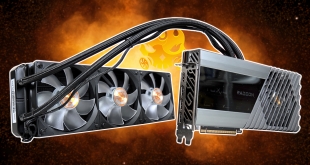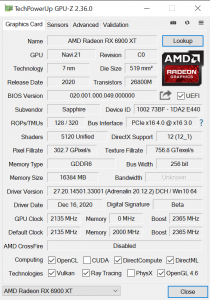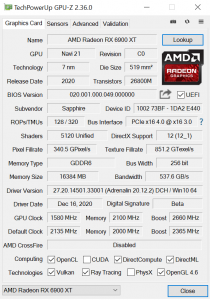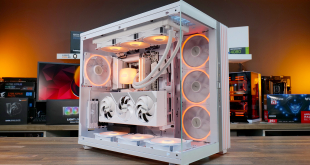
It's been some years since we last looked at a graphics card from Sapphire's Toxic brand, but that changes today. Toxic is back, and it's back with a bang, as we review the RX 6900 XT Toxic Limited Edition, featuring a 360mm all-in-one liquid cooler. Sapphire claims this is the fastest RX 6900 XT on the market, with a rated boost clock of 2660MHz when using the card's ‘Toxic Boost' mode. Let's see if that claim holds true.
As far as I can tell, the last Sapphire Toxic graphics card to hit the market was the R9 390, all the way back in May 2016, so it's been almost five years without a proper flagship card from Sapphire. The Toxic RX 6900 XT Limited Edition is the first Toxic card to come with an integrated all-in-one liquid cooling solution which cools the GPU, while a fan and two heatpipes deal with the VRM and memory.
With its Toxic brand geared for all-out performance, Sapphire has also implemented what it calls ‘Toxic Boost', a one-click overclock which is accessible via the TriXX software. This raises the GPU's boost clock from 2365MHz up to 2660MHz, bumps up power draw to 400W total board power and also increases memory speeds by 0.8Gbps.
There's also the choice between the Performance and Quiet BIOS, plenty of RGB lighting as well as a beefed-up PCB compared to reference. Let's see what this card is really about.
| RX 6900 XT | RX 6800 XT | RX 6800 | RX 5700 XT | RX 5700 | |
| Architecture | RDNA 2 | RDNA 2 | RDNA 2 | RDNA | RDNA |
| Manufacturing Process | 7nm | 7nm | 7nm | 7nm | 7nm |
| Transistor Count | 26.8 billion | 26.8 billion | 26.8 billion | 10.3 billion | 10.3 billion |
| Die Size | 519 mm² | 519 mm² | 519 mm² | 251 mm² | 251mm² |
| Ray Accelerators | 80 | 72 | 60 | n/a | n/a |
| Compute Units | 80 | 72 | 60 | 40 | 36 |
| Stream Processors | 5120 | 4608 | 3840 | 2560 | 2304 |
| Game GPU Clock | Up to 2015MHz | Up to 2015MHz | Up to 1815MHz | Up to 1755MHz | Up to 1625MHz |
| Boost GPU Clock | Up to 2250MHz | Up to 2250MHz | Up to 2105MHz | Up to 1905MHz | Up to 1725MHz |
| Peak SP Performance | Up to 23.04 TFLOPS | Up to 20.74 TFLOPS | Up to 16.17 TFLOPS | Up to 9.75 TFLOPS | Up to 7.95 TFLOPS |
| Peak Half Precision Performance | Up to 46.08 TFLOPS | Up to 41.47 TFLOPS | Up to 32.33 TFLOPS | Up to 19.5 TFLOPS | Up to 15.9 TFLOPS |
| Peak Texture Fill-Rate | Up to 720 GT/s | Up to 648.0 GT/s | Up to 505.2 GT/s | Up to 304.8 GT/s | Up to 248.4 GT/s |
| ROPs | 128 | 128 | 96 | 64 | 64 |
| Peak Pixel Fill-Rate | Up to 288.0 GP/s | Up to 288.0 GP/s | Up to 202.1 GP/s | Up to 121.9 GP/s | Up to 110.4 GP/s |
| AMD Infinity Cache | 128MB | 128MB | 128MB | n/a | n/a |
| Memory | 16GB GDDR6 | 16GB GDDR6 | 16GB GDDR6 | 8GB GDDR6 | 8GB GDDR6 |
| Memory Bandwidth | 512 GB/s | 512 GB/s | 512 GB/s | 448 GB/s | 448 GB/s |
| Memory Interface | 256-bit | 256-bit | 256-bit | 256-bit | 256-bit |
| Board Power | 300W | 300W | 250W | 225W | 185W |
The make-up of the RX 6900 XT GPU has many similarities to the RX 6800 XT. Still fabricated on TSMC’s 7nm process node, it uses the same Navi 21 GPU, measuring 519 mm². The key difference is that the RX 6900 XT silicon is fully populated, with 80 Compute Units (CUs) compared to 72 for the 6800 XT. This means the flagship chip has an extra 512 Stream Processors, giving a grand total of 5120 shaders.
Rated clock speed is also identical between these two RDNA 2 GPUs. Reference RX 6900 XT has a rated game clock of 2015MHz and a rated boost clock of up to 2250MHz, but Sapphire has pushed the rated boost clock up to 2365MHz for the Performance BIOS. Enabling Toxic Boost sees this increase by almost 300MHz, to 2660MHz.
AMD has also increased the memory capacity, with 16GB of GDDR6 memory found on every RX 6000 SKU (so far). The memory is clocked at 16Gbps (or 16.8Gbps using Toxic Boost), and operates over a 256-bit memory interface for total bandwidth of 512 GB/s. However, AMD has also implemented a 128MB Infinity Cache on the Navi 21 GPU, to significantly increase effective memory bandwidth without excess power draw.
Speaking of power, the reference RX 6900 XT has a rated total board power (TBP) of 300W. Sapphire has increased this for both the Quiet and Performance BIOS, to 350W and 360W respectively, but we look at power draw in more detail later on in the review.
 KitGuru KitGuru.net – Tech News | Hardware News | Hardware Reviews | IOS | Mobile | Gaming | Graphics Cards
KitGuru KitGuru.net – Tech News | Hardware News | Hardware Reviews | IOS | Mobile | Gaming | Graphics Cards





